Mårten Boström won a very popular Gold medal on home ground in the World Championships Sprint today – literally running away from his competitors with higher running speed on the longer legs. In the women’s class Simone Niggli took an expected gold medal – but Annika Billstam got very close in the end after a non-optimal route choice by Niggli.
The World Champion from 2012 – Matthias Kyburz – had a clear lead after 2/3 of the race, but then Kyburz made a fatal mistake on his way to control 17.
The fatal 17th control
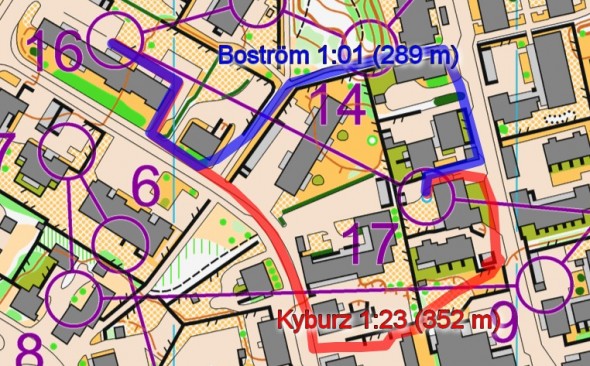
There is no doubt which two controls will feature in Kyburz’s nightmares the coming months
First Kyburz took the slower southern route choice – and then he lost control and suddenly stood in a crossing without knowing were he was. In total this mistake and wrong route choice cost Kyburz 23 seconds to the best split time – 22 seconds to Boström. To 18 Kyburz made a followup-mistake – loosing another 9 seconds – and suddenly Kyburz was out of the fight for medal. With 26 seconds up to Gold at the finish, there is no doubt which two controls will feature in Kyburz’s nightmares the coming months…
While Kyburz now was out of the fight for Gold, Boström’s lead was only 3 seconds down to the young Danish runner Rasmus Thrane Hansen with Jonas Leandersson, Fabian Hertner and Scott Fraser another 3 seconds behind when arriving at the 19th control – ready for long route choice leg of the day. This long leg was Thrane Hansen’s demise – losing as much as 17 seconds to Boström by taking extra climb and going over the top on paths instead of staying down on harder ground. Leandersson and Hertner also lost some seconds on their route choice.
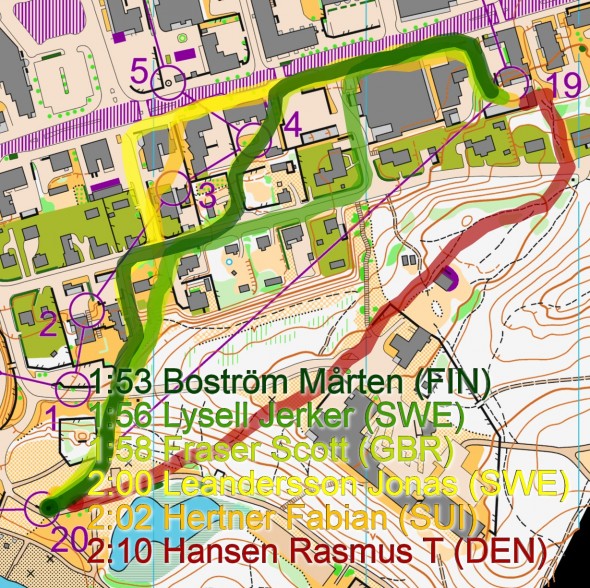
The illustrations below shows a comparison between Thrane Hansen and Boström, connecting the points were they would have been at the same time if starting together at control 19. Thrane Hansen first looses time up the hill – then is slower in the terrain – and finally is significantly slower running down the hill. While Boström runs between 3 and 4 min/km for most of the leg – just going up to around 5 min/km up the hill – Thrane Hansen is nearly up at 6 min/km for the first half minute of running on the leg. At the top of the hill he manages to run below 4 min/km, but in the downhill Thrane Hansen is again up to around 4:30 min/km. Remember that Thrane Hansen and Boström had nearly equal speed earlier in the course – although Boström was somewhat faster on the long legs with a lot of pure running.
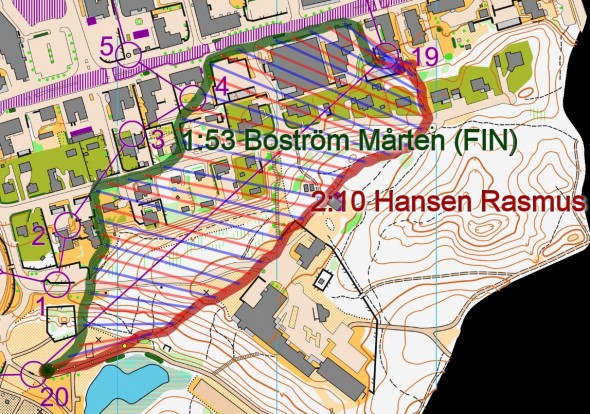
Fight for top 6
With Thrane Hansen out, there were still three runners fighting for the medals. Fabian Hertner lost the battle due to a mistake to control 22 – a mistake he described as a small mistake, but which nevertheless cost him a medal.
The splitsbrowser below shows the fight for Top 6 in the mens class. As you can see Fraser decided silver for himself on the leg to the finish – after being equal with Jonas Leandersson on the last control. Generally Boström was faster than Kyburz and the others on the longer legs – but is seems like Kyburz has an edge on the trickier short legs – an advantage the Swiss could not turn into victory today.
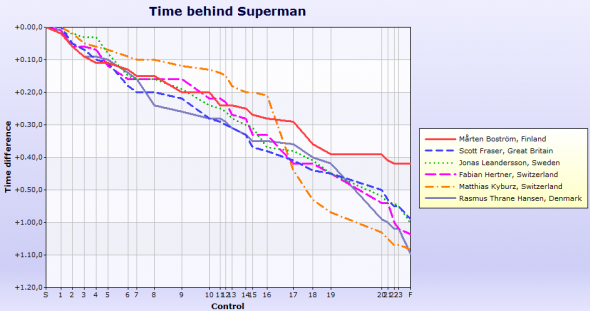
Detailed splits analysis – leg by leg
From this detailed split analysis you can see how the legs to control 17, 18 and 20 are the most decisive one in the race overall – where most runners lose time. Control 18 is also one of the legs where Boström looses most time.
Niggli challenged towards the end
Simone Niggli had the highest speed in today’s sprint as so often before. Before the long route choice leg from 16 to 17 – which was equal to the men’s long leg – Niggli had built a significant lead of 26 seconds by running several best leg times – especially dominating on the long legs. This is illustrated in the splitsbrowser below – a horizontal line indicating the best split time on a leg.
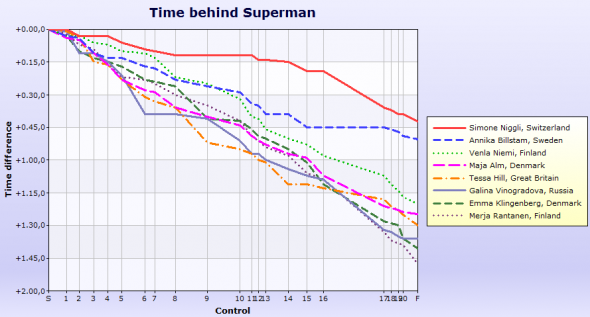
Billstam really finds her top speed on this leg and is 5 seconds faster than the next woman
As you can see, Niggli looses nearly all the lead she has built up on the rest of the course on the leg to number 17. The lead shrinks with 17 seconds – from 26 seconds down to 9 seconds. Niggli’s mistake is the same as Thrane Hansen’s – going left over the hill. Billstam on the other hand takes the same choice as Boström – running fast on hard surface. Just as Boström, Billstam really finds her top speed on this leg and is 5 seconds faster than the next woman. Niemi also chooses the same route as Billstam – compared to Maja Alm running over the hill. This probably saves the bronze medal for Niemi as Alm runs fast on Niggli’s route.
1 meter shorter – 17 seconds slower
On the illustration below you see how Niggli’s choice is just as long as Billstam’s – but with the added ascent, the paths instead of hard ground and the downhill in terrain at the end of the leg. Rantanen chooses another option which is similar in running time to the one of Niggli with similar characteristics.
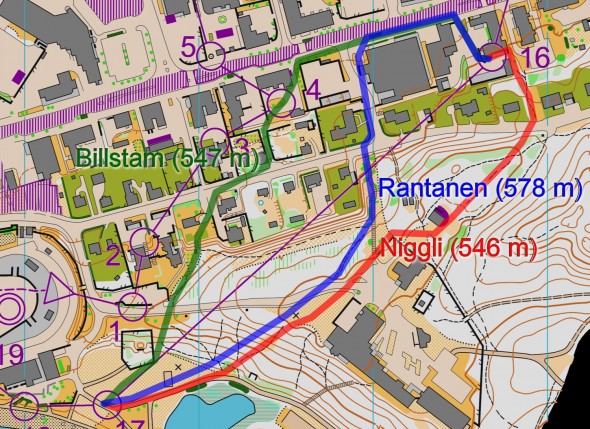
Maps and GPS-data
|
July 8th 2013 – GPSSeuranta
|
July 8th 2013 – GPSSeuranta
GPS: WOC Sprint Final Men
|
Results
Men
| 1 | 132 | Mårten Boström | Finland | 14:19.6 | |||
| 2 | 142 | Scott Fraser | Great Britain | 14:36.7 | +17.1 | ||
| 3 | 133 | Jonas Leandersson | Sweden | 14:37.8 | +18.2 | ||
| 4 | 141 | Fabian Hertner | Switzerland | 14:41.3 | +21.7 | ||
| 5 | 143 | Matthias Kyburz | Switzerland | 14:45.8 | +26.2 | ||
| 6 | 144 | Rasmus Thrane Hansen | Denmark | 14:47.3 | +27.7 | ||
| 7 | 145 | Øystein Kvval Østerbø | Norway | 14:49.4 | +29.8 | ||
| 8 | 146 | Jerker Lysell | Sweden | 14:52.3 | +32.7 | ||
| 9 | 106 | Murray Strain | Great Britain | 14:56.4 | +36.8 | ||
| 10 | 134 | Jan Prochazka | Czech Republic | 14:56.8 | +37.2 | ||
| 11 | 135 | Andreas Kyburz | Switzerland | 14:58.2 | +38.6 | ||
| 12 | 137 | Yannick Michiels | Belgium | 15:06.3 | +46.7 | ||
| 13 | 105 | Pavlo Ushkvarok | Ukraine | 15:06.7 | +47.1 | ||
| 14 | 140 | Jonas Vytautas Gvildys | Lithuania | 15:13.6 | +54.0 | ||
| 15 | 113 | Tuomo Mäkelä | Finland | 15:17.9 | +58.3 | ||
| 16 | 123 | Kristian Jones | Great Britain | 15:18.8 | +59.2 | ||
| 17 | 117 | Gustav Bergman | Sweden | 15:19.9 | +1:00.3 | ||
| 18 | 116 | Bjørn Ekeberg | Norway | 15:21.8 | +1:02.2 | ||
| 19 | 125 | Petteri Muukkonen | Finland | 15:23.2 | +1:03.6 | ||
| 20 | 136 | Oleksandr Kratov | Ukraine | 15:24.3 | +1:04.7 |
Women
| 1 | 43 | Simone Niggli | Switzerland | 14:10.6 | |||
| 2 | 37 | Annika Billstam | Sweden | 14:18.7 | +8.1 | ||
| 3 | 30 | Venla Niemi | Finland | 14:48.5 | +37.9 | ||
| 4 | 45 | Maja Alm | Denmark | 14:53.0 | +42.4 | ||
| 5 | 31 | Tessa Hill | Great Britain | 14:58.2 | +47.6 | ||
| 6 | 44 | Galina Vinogradova | Russia | 15:04.3 | +53.7 | ||
| 7 | 42 | Emma Klingenberg | Denmark | 15:08.9 | +58.3 | ||
| 8 | 40 | Merja Rantanen | Finland | 15:15.9 | +1:05.3 | ||
| 9 | 36 | Heidi Bagstevold | Norway | 15:20.8 | +1:10.2 | ||
| 10 | 38 | Anne-M Hausken Nordberg | Norway | 15:22.8 | +1:12.2 | ||
| 11 | 39 | Nadiya Volynska | Ukraine | 15:34.5 | +1:23.9 | ||
| 12 | 15 | Lina Strand | Sweden | 15:35.0 | +1:24.4 | ||
| 13 | 28 | Iveta Duchova | Czech Republic | 15:38.4 | +1:27.8 | ||
| 14 | 26 | Lizzie Ingham | New Zealand | 15:39.6 | +1:29.0 | ||
| 15 | 16 | Olga Rieznychenko | Ukraine | 15:49.3 | +1:38.7 | ||
| 16 | 32 | Rahel Friederich | Switzerland | 15:53.9 | +1:43.3 | ||
| 17 | 21 | Léa Vercellotti | France | 15:54.3 | +1:43.7 | ||
| 18 | 24 | Irina Nyberg | Russia | 15:54.7 | +1:44.1 | ||
| 19 | 29 | Ausrine Kutkaite | Lithuania | 15:54.9 | +1:44.3 | ||
| 20 | 18 | Sarah Rollins | Great Britain | 16:01.5 | +1:50.9 |
 World of O News
World of O News
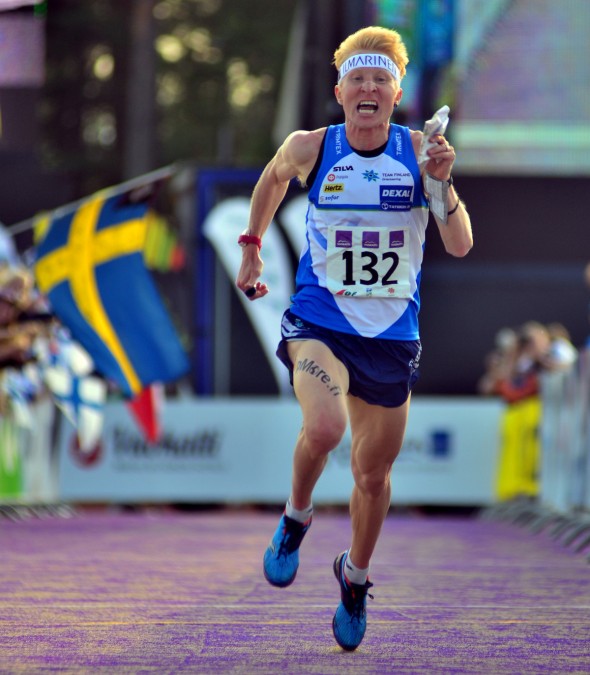

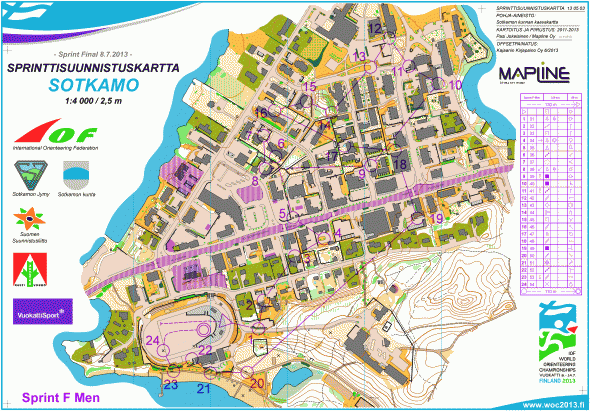
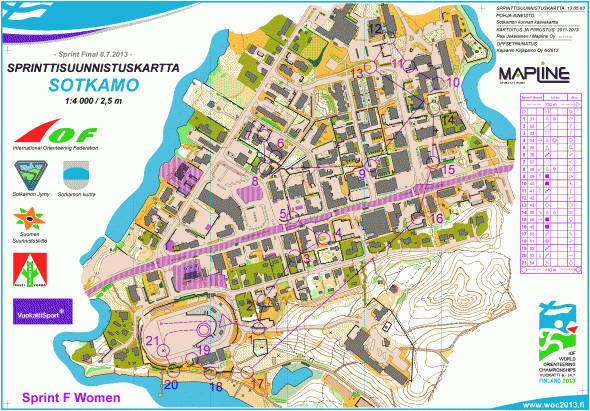


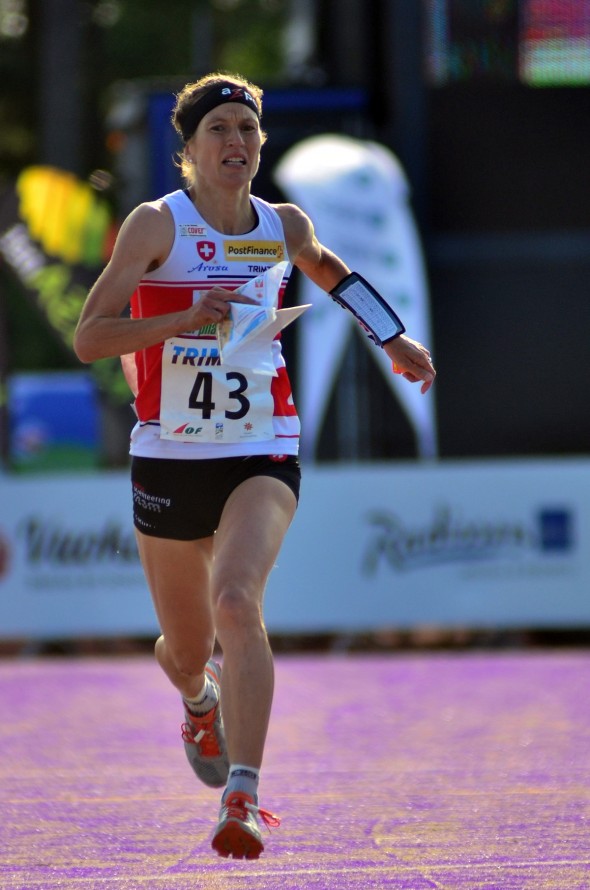



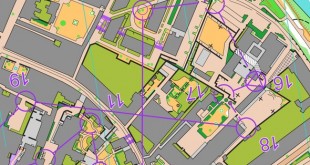
Judith Wyder missed the podium by hopping over the 19th control. http://www.solv.ch
@Martin: according to gps it was not only 19th control it was 19th and 20th control. So she hopped over 2 controls
@Eric: you´re right. And she did not miss the podium by doing so, she only “seemed to miss the podium” (cited text) lying 9 seconds behind Niemi at the 18th control.
Nope. The extra time it would take her to visit the missing controls, would put her out of the podium anyway…
just as a short information: Wrong title “1 meter longer – 17 seconds slower” it should be: “1 meter shorter – 17 seconds slower”
Thanks :)
Please, take a look on map samples on the official site:
http://www.woc2013.fi/ssl/woc.nsf/sp?Open&cid=maps
Looks like athletes have to be prepared to combination of simple city sprint and forest sprint. Same impressions you can get from old map:
http://www.woc2013.fi/SSL/woc.nsf/0/C51573558B8DE778C22578B9002E77BC/$FILE/Hiukka.pdf
In fact, WOC-final was a city-sprint with a labyrinth of fences!
Mårten Boström wrote on his page: “I know how to tackle the trickiest labyrinths in full speed”
If you (Finnish runners) have a relevant knowledge about true terrain, you can design best strategy of preparation.
I have feelings, that this situation is far away from declared “Fair play”.
Mikhail, every (elite) team knew that there would be more fences.
Do you really think that Mårten ment that he knew the places of those fences? You should be very carefull with such accusations.
What feeling do you have from last year’s sprint? How come swiss men were that superior? I got a feeliing that they were just that good.
I am one of the Russian National coaches. Russian team does not have this information in advance.
Samples of map should reflect true map situation.
It is another way of long-term preparation. You can spend limited time to train combination of forest sprint and urban sprint or you can spend training time to speed route choices around fences.
I dont know how are typical Finnish towns look like. And dozens of other teams dont know. We are analysing official information (map samples, borders of forbiden area, old maps). And according to this information (old borders of forbiden area include a LOT of forest, map sample does not reflect true competition map) coaches design long-term program of preparation.
Just imagine – e.g. WOC-map sample include a lot of marshes. You are thinking: OK, my runners should be prepared for this. But when you spend one year of trainings inside different marshes and came to competition – there are no marhses at all! Is it fair?..
I wanted mainly to emphasize that your accusations are quite severe – especially if you are one the the coaches – if you say that finnish team had received more information about the terrain from the organizers. (And do you think that the information was given only to Boström?)
I think that it was just normal “homeground advantage” – the same as the Swiss had last year.
Regarding official preliminary information, I also expected more forest – maybe 1/3 of the course. But I was also sure that there will be some new fences because they have used them in Finland in many other sprints. And I’m not in any way involved in Finnish national team or WOC organizers.
Almost all nations (except Scandinavians and Swiss) dont have resources to participate on the regular base in Euromeetings or World Cup Events or Finnish competitions. Main source of information for us is in WOC bulletins and map samples. Take a look:
http://3.bp.blogspot.com/-EcCDGsnrexs/UdzRy16Kk1I/AAAAAAAAAkI/TJa5yCVAKoM/s1600/WOC+map+saple.jpg
http://3.bp.blogspot.com/-dRoWNsv8kgQ/UdzSH0-cGfI/AAAAAAAAAkQ/68-NxCXZHWM/s1600/True+competition+situation.gif
Do you see differences??
I am Halden SK main coach in 2011 and 2012, Russian National coach from 2009. I have never visited forbidden areas, I always use open sources of information (bulletins, map samples and official training maps). According to all this information for me it is not clear that my runners have to be ready to fences labyrinths without any forest at all. For Mårten it was obviously that (citation): “I know how to tackle the trickiest labyrinths in full speed”
I dont blame any one, I dont say that source of this extra information of Mårten is WOC-organizers. I just say about facts.
In my opinion, even if you are living in South Africa of Brasil, you have to get correct relevant information from WOC-organizers IN ADVANCE (then you have a chance to develop successful training program, design relevant WOC-test races and plan relevant training camps).
Mikhail, I had expected, purely based on the World Cup maps from NORT last year (which I studied because I considered NORT 2012 in Kajaani/Vuokatti a “WOC test event”), that there would be a lot of artificial boundaries in this year’s WOC sprint. This material I guess should be a natural part of the preparations for the WOC sprint? I found these maps on the Internet.
Based partly on this we also used quite extensively artificial boundaries in our training camp at Bergen Sprint Camp this winter (were Boström also was present and training this ability :)
Unspectacular Finnish cities have been pimped for sprint orienteering with artificial fences, which should be known from the 2012 NORT. The result is an impressive 2013 WOC sprint course with dual route choices on almost every leg and multiple route choices on some legs. The best sprint orienteers on that day rather than the best runners have won. Congratulations to the course setters, in my opinion, it was worth the extra efforts.
Courses were excellent. Thats true!